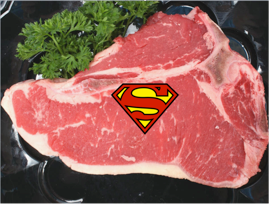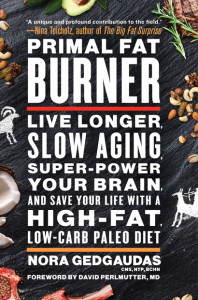
100% Pasture-fed Animal Fats: Villain or Under-appreciated Superfood?
You might be asking yourself what something like animal fat is doing in a discussion about superfoods? People expect to see things like broccoli sprouts, avocados, turmeric and blueberries when it comes to this topic, and animal source foods are rarely considered in this discussion. I believe the time has come to turn this around. When I looked at the mountain of research on this topic that I pored through in writing my recently released book, Primal Fat Burner, I realized that there was a long overdue and radically under appreciated story that needed to be told.
For over 100,000 generations of human evolutionary history our ancestral forebears led a purely hunter-gatherer lifestyle, and more research has come to light in recent years underscoring the fact that we have been mostly hunters throughout the majority of this time, between roughly 2.6 million years ago to just about 10,000 years ago when we adopted a more agriculturally-based lifestyle and began eating a more carbohydrate-based diet. The first signs of what we call the “diseases of modern civilization” began to emerge at that time; radically accelerating since then following the industrial revolution. And our supposedly short life span reduced further by roughly HALF.
Prior to all that, highly coveted dietary fat from the wide variety of animals and fatty megafauna that we habitually hunted supplied us with the structural basis for our most distinctly unique human characteristic: our extremely large and sophisticated brains. Our brains are, in fact, constructed from the very fats we supply them with by what we choose to eat. And two fatty acids in particular: arachidonic acid (AA) and docosahexaenoic acid (DHA)– unique 20- and 22-carbon fatty acids found more or less exclusively within fully pasture-fed/naturally wild-foraged animal source foods– are utterly key to human cognition.[1] AA makes up at least 11% of the fatty acids needed by the brain and lower levels are associated with cognitive decline. DHA “is essential for the growth and functional development of the brain in infants. DHA is also required for maintenance of normal brain function in adults. The inclusion of plentiful DHA in the diet improves learning ability, whereas deficiencies of DHA are associated with deficits in learning.”[2] And while DHA is also popularized as being richly found in fatty, cold water fish, our evolutionary antecedants most commonly got their primary share of DHA from mainly animal fats, which offered both needed brain fats (DHA and AA) in a healthy balance. Although arachidonic acid (AA) is sometimes vilified as being pro-inflammatory, this really is not an issue where sufficient EPA and DHA are also present. And you simply cannot have a healthy brain without AA. It’s all about the relative balance of natural fatty acids and not any given one, in and of itself.
The preponderance of omega-6 fats in factory farmed or feedlot meat is a much greater cause for concern. Anti-inflammatory omega-3’s are richly found in fully grassfed meats (and absent from feedlot or factory farmed meat). [3] [4] [5] This more appropriate balance naturally occurs in animal source foods fed in a manner most similar to those our ancestors would have hunted (i.e., from animals naturally and exclusively consuming fresh, green forage/grass). By eating exclusively grass-fed sources of animal fats we supply our bodies with a rich plethora of vital nutrients critical to the health of your body and brain you would be hard-pressed to find elsewhere. “Research spanning three decades suggests that grass-based diets can significantly improve the fatty acid (FA) composition and antioxidant content of beef…” And “Grass-based diets have been shown to enhance total conjugated linoleic acid (CLA) isomers, trans vaccenic acid (TVA), a precursor to CLA, and omega-3 fatty acids on a [gram for gram of] fat basis.” Plus “Several studies suggest that grass-based diets elevate precursors for Vitamin A and E, as well as cancer fighting antioxidants such as glutathione (GT) and superoxide dismutase (SOD) activity as compared to grain-fed contemporaries.”[6]
Wow…talk about a superfood!
As just mentioned in this last study, pastured animal fats are also especially rich in a particularly important fatty acid known as CLA (conjugated linoleic acid). What’s so special about that?
Plenty.
CLA has actually been shown to show positive benefits for not only cancer[7] [8] [9] [10] [11] but also obesity[12] [13] [14] [15] [16] [17] [18] [19] [20] [21] [22] [23] [24] [25] autoimmunity,[26] [27] infections,[28] inflammation,[29] [30] bone health[31], diabetes.[32] [33] [34] [35] and even heart disease![36]
In fact, natural, animal source CLA may be one of the most broadly beneficial and potent cancer-fighting substances in our diet. It is somewhat uniquely able to (in very small amounts) block all three stages of cancer: 1) initiation 2) growth/promotion and 3) metastasis. Most “anticancer nutrients” are typically helpful in only one of these areas. To date, beneficial effects of natural CLA from animal fat have been found in cancers of the breast, prostate, colon and skin. In animal studies, as little as one half of one percent CLA in the diet of experimental animals reduced tumor burden by more than 50 percent.[37] As if this wasn’t exciting enough, there is more direct evidence that CLA may reduce cancer risk in humans. In a Finnish study, women who had the highest levels of CLA in their diet had a 60 percent lower risk of breast cancer than those having the lowest levels. Switching from grain-fed to exclusively grass-fed meat literally places women in this lowest risk category! Additionally, French researchers measured CLA levels in the breast tissues of 360 women and found that the women with the most CLA had the lowest risk of cancer. In fact, the women with the most CLA had a staggering 74% lower risk of breast cancer than the women with the least CLA. [38] Other studies have additionally shown breast cancer and even colon cancer preventative benefits.[39] [40] [41] [42] In keeping with this, CLA additionally exerts potent anti-inflammatory effects.[43] The inherent stability of CLA also seems to maintain itself even when meat is cooked.[44] [45] One study pointed put the following, “Of the vast number of naturally occurring substances that have been demonstrated to have anticarcinogenic activity in experimental models, all but a handful of them are of plant origin. Conjugated linoleic acid is unique because it is present in food from animal sources, and its anticancer efficacy is expressed at concentrations close to human consumption levels.”[46]
Not only this, but natural CLA from 100% grass-fed animals has anti-inflammatory[47] and immune-modulatory properties, making it an important addition to any autoimmune dietary protocol.
You won’t get this from a CLA pill (even though they sell them!)
But it’s important to point out that (invariably synthetic) CLA supplements (capsules) sold in health food stores do NOT have the same benefits as the form of CLA in grass-fed meat—and in fact may even be counterproductive to your health! ONLY CLA from the fat of wild game and fully pastured animals has the real anticancer health benefits you want.[48] Another study showed that cows grazing green pasture and receiving no supplemental feed had 500% more conjugated linoleic acid in milk fat than cows fed typical feedlot diets.[49]
As supplements go, the emu oil caps/liquid I often recommend by Walkabout Health Products additionally contain appreciable levels of CLA and contain the only natural source of supplemental CLA and vitamin K2 (MK-4 form) I am aware of in the marketplace.
So what are my favorite CLA-rich, animal fat superfoods to cook with? When it comes to fully pastured and organic beef tallow, I am partial to the brand name, ‘Fatworks’. They also carry other exceptional quality and nutrient dense, flavorful animal fats one can (and should) cook with. Another high quality dietary source of CLA and other critical fat-soluble nutrients often missing in many diets can be enjoyed in a particular form of 100% grass-fed and organic Cultured Ghee sold by a wonderful company called ‘Pure Indian Foods’. This is actually the only dairy product I ever consume, mainly for the reason that it has been lab tested to show “undetectable” levels of dairy proteins. This can be important for anyone suffering from an immune reactivity to dairy proteins, as well as many forms of autoimmunity. Pure Indian Foods also sells a fantastic Turmeric Superghee, which contains 800 mg of organic turmeric (tested lead-free), rich in curcumanoids known to have a vast range of health benefits.
NOTE: I have no financial ties to these companies, but promote them because of their unwavering integrity.
A vast body of research shows us (as does common sense, given how well adapted the human genome is to animal source foods) that animal fats are not necessarily the villains they have long been made out to be. In fact, they may not only be central to your best health (when used in the right way—in the absence of sugary/starchy foods), but may also be literally central to what made us human in the first place.
It’s hard to beat pastured animal fats for their ultimate superfood potential!
~ Nora
For more information or to order my new book, please see www.primalfatburner.com. Join me and many others on my weekly online education series Primal Restoration TM.

References
[1] Kotani S, Sakaguchi E, Warashina S, et al. “Dietary supplementation of arachidonic and docosahexaenoic acids improves cognitive function.” Neuroscience Research. 2006. Doi: 10.1016/j.neures.2006.06.010
[2] Horrocks LA, Yeo YK. “Health benefits of docosahexaenoic acid (DHA).” Pharmacol Res. 1999 Sep;40(3):211-25.
[3] Rose, D. P., J. M. Connolly, et al. (1995). “Influence of Diets Containing Eicosapentaenoic or Docasahexaenoic Acid on Growth and Metastasis of Breast Cancer Cells in Nude Mice.” Journal of the National Cancer Institute 87(8): 587-92.
[4] Tisdale, M. J. (1999). “Wasting in cancer.” J Nutr 129(1S Suppl): 243S-246S.
[5] Tashiro, T., H. Yamamori, et al. (1998). “n-3 versus n-6 polyunsaturated fatty acids in critical illness.” Nutrition 14(6): 551-3.
[6] Daley CA, Abbott A, Doyle PS, et al. “A review of fatty acid profiles and antioxidant content in grass-fed and grain-fed beef.” Nutr J. 2010; 9: 10.
[7] Pariza MW, Hargraves WA. “A beef-derived mutagenesis modulator inhibits initiation of mouse epidermal tumors by 7,12-dimethylbenz[a]anthracene.” Carcinogenesis 1985;6:591–3.
[8] Ip, C., J. A. Scimeca, et al. (1994). “Conjugated linoleic acid. A powerful anticarcinogen from animal fat sources.” Cancer 74(3 Suppl): 1050-4.
[9] Białek A, Tokarz A. “[Conjugated linoleic acid as a potential protective factor in prevention of breast cancer].” Postepy Hig Med Dosw (Online). 2013 Jan 11;67:6-14.
[10] Heinze VM, Actis AB. “Dietary conjugated linoleic acid and long-chain n-3 fatty acids in mammary and prostate cancer protection: a review.” Int J Food Sci Nutr. 2012 Feb;63(1):66-78. doi: 10.3109/09637486.2011.598849. Epub 2011 Jul 15.
[11] Chin SF, Liu W, Storkson JM, HaYL, Pariza MW. “Dietary sources of conjugated dienoic isomers of linoleic acid, a newly recognized class of anticarcinogens.” J Food Comp Anal 1992; 5:185-197.
[12] Atkinson RL, Whigham LD. “Effects of CLA on body composition and metabolic variables in humans.” Internet: http://www.aocs.org/archives/am2003/session.asp?strsession=ana1
[13] Brown JM, Boysen MS, Jensen SS, et al. “Isomer-specific regulation of metabolism and PPAR signaling by CLA in human preadipocytes.” J Lipid Res 2003;44:1287–300.
[15] Brown JM, McIntosh MK. “Conjugated linoleic acid in humans: regulation of adiposity and insulin sensitivity.” J Nutr 2003;133:3041–6.
[16] Kennedy A, Martinez K, Schmidt S, et al. “Antiobesity Mechanisms of Action of Conjugated Linoleic Acid.” J Nutr Biochem. 2010 Mar; 21(3): 171–179. doi: 10.1016/j.jnutbio.2009.08.003
[17] Miner JL, Cederberg CA, Nielsen MK, et al. “Conjugated linoleic acid (CLA), body fat, and apoptosis.” Obes Res. 2001 Feb;9(2):129-34.
[18] West DB, Blohm FY, Truett AA, DeLany JP. “Conjugated linoleic acid persistently increases total energy expenditure in AKR/J mice without increasing uncoupling protein gene expression.” J Nutr. 2000 Oct;130(10):2471-7.
[19] Evans M, Lin X, Odle J, McIntosh M. “Trans-10, cis-12 conjugated linoleic acid increases fatty acid oxidation in 3T3-L1 preadipocytes.” J Nutr. 2002 Mar;132(3):450-5.
[20] LaRosa PC, Miner J, Xia Y, et al. “Trans-10, cis-12 conjugated linoleic acid causes inflammation and delipidation of white adipose tissue in mice: a microarray and histological analysis.” Physiol Genomics. 2006 Nov 27;27(3):282-94. Epub 2006 Jul 25.
[21] Blankson H, Stakkestad JA, Fagertun H, et al. “Conjugated Linoleic Acid Reduces Body Fat Mass in Overweight and Obese Humans.” J Nutr. December 1, 2000 vol. 130 no. 12 2943-2948
[22] Chen SC, Lin YH, Huang HP, et al. “Effect of conjugated linoleic acid supplementation on weight loss and body fat composition in a Chinese population.” Nutrition. 2012 May;28(5):559-65. doi: 10.1016/j.nut.2011.09.008. Epub 2012 Jan 20.
[23] Watras AC, Buchholz AC, Close RN, et al. “The role of conjugated linoleic acid in reducing body fat and preventing holiday weight gain.” Int J Obes (Lond). 2007 Mar;31(3):481-7. Epub 2006 Aug 22.
[24] Blankson H, Stakkestad JA, Fagertun H, et al. “Conjugated linoleic acid reduces body fat mass in overweight and obese humans.” J Nutr. 2000 Dec;130(12):2943-8.
[25] Steck SE, Chalecki AM, Miller P, et al. “Conjugated linoleic acid supplementation for twelve weeks increases lean body mass in obese humans.” J Nutr. 2007 May;137(5):1188-93.
[26] Yang MD, Pariza MW, Cook ME. “Dietary conjugated linoleic acid protects against end stage disease of systematic lupus erythematosus in the NZB/W F1 mouse.” Immunopharm Immunotox 2000;22:433–49.
[27] Whigham LD, Higbee A, Bjorling DE, Park YH, Pariza MW, Cook ME. “Decreased antigen-induced eicosanoid release in conjugated linoleic acid-fed guinea pigs.” Am J Physiol 2002;282:R1104–12.
[28] Bassaganya-Riera J, Pogranichniy RM, Jobgen SC, et al. “Conjugated linoleic acid ameliorates viral infectivity in a pig model of virally induced immunosuppression.” J Nutr 2003;133:3204–14.
[29] Whigham LD, Cook EB, Stahl JL, et al. “CLA reduces antigen-induced histamine and PGE(2) release from sensitized guinea pig tracheae.” Am J Physiol 2001;280:R908–12.
[30] Bassaganya-Riera J, Hontecillas R, Beitz DC. “Colonic anti-inflammatory mechanisms of conjugated linoleic acid.” Clin Nutr 2002;21:451–9.
[31] Watkins, B. A. and M. F. Seifert (2000). “Conjugated linoleic acid and bone biology.” J Am Coll Nutr 19(4): 478S-486S.
[32] Hamura M, Yamotoya H, Kudo S. “Glycerides rich in conjugated linoleic acid (CLA) improve blood glucose control in diabetic C57BLKS-Leprdb/leprdb(db/db) mice.” J Oleo Sci 2001;50:889–94.
[33] Belury, MA. “Conjugated linoleic acids in type 2 diabetes mellitus: implications and potential mechanisms.” In: Sebedio JL, Christie WW, Adlof R, eds. Advances in conjugated linoleic acid research. Vol 2. Champaign, IL: AOCS Press, 2003:302–15.
[34] Roche HM, Noone E, Sewter C, et al. “Isomer-dependent metabolic effects of conjugated linoleic acid: insights from molecular markers sterol regulatory element-binding protein-1c and LXR.” Diabetes 2002;51:2037–44.
[35] Castro-Webb N, Ruiz-Narváez EA, Campos H. “Cross-sectional study of conjugated linoleic acid in adipose tissue and risk of diabetes.” Am J Clin Nutr. 2012 Jul;96(1):175-81. doi: 10.3945/ajcn.111.011858. Epub 2012 May 30.
[36] Smit LA, Baylin A and Campos H. “Conjugated linoleic acid in adipose tissue and risk of myocardial infarction.” Am J Clin Nutr July 2010
vol. 92 no. 1 34-40.
[37] Daley CA, Abbott A, Doyle P, et al. “A literature Review of the Value-Added Nutrients Found in Grass-Fed Beef Products.” Nutrition Journal, June 2006
[38] A. Aro et al, Kuopio University, Finland; Bougnoux, P, Lavillonniere F, Riboli E. “Inverse relation between CLA in adipose breast tissue and risk of breast cancer. A case-control study in France.” Inform 10;5:S43, 1999
[39] Ip C, Dong Y, Ip MM, et al. “Conjugated linoleic acid isomers and mammary cancer prevention.” Nutr Cancer 2002;43:52–8.
[40] Masso-Welch PA, Zangani D, Ip C, et al. “Inhibition of angiogenesis by the cancer chemopreventive agent conjugated linoleic acid.” Cancer Res 2002;62:4383–9.
[41] Kemp MQ, Jeffy BD, Romagnolo DF. “Conjugated linoleic acid inhibits cell proliferation through a p53-dependent mechanism: effects on the expression of G1-restriction points in breast and colon cancer cells.” J Nutr 2003;133:3670–7.
[42] Aro, A., S. Mannisto, I. Salminen, M. L. Ovaskainen, V. Kataja, and M. Uusitupa. “Inverse Association between Dietary and Serum Conjugated Linoleic Acid and Risk of Breast Cancer in Postmenopausal Women.” s 38, no. 2 (2000): 151-7.)
[43] Yu Y, Correll PH, Vanden Heuvel JP. “Conjugated linoleic acid decreasesproduction of pro-inflammatory products in macrophages: evidence for a PPARγ-dependent mechanism. Biochimica et Buiohysica Acta 2002. 1581:89-99.
[44] Ha YL, Grimm NK, Pariza MW. “Anticarcinogens from fried ground beef: heat altered derivatives of linoleic acid.” Carcinogenesis 1987;8:1881–7.
[45] Lin Yang, Ying Cao, Zhen-Yu Chen; Cao; Chen (2004). “Stability of conjugated linoleic acid isomers in egg yolk lipids during frying”. Food Chemistry (Elsevier) 86 (4): 531–535. doi:10.1016/j.foodchem.2003.09.006
[46] Ip, C., J. A. Scimeca, et al. (1994). “Conjugated linoleic acid. A powerful anticarcinogen from animal fat sources.” Cancer 74(3 Suppl): 1050-4.
[47] Bassaganya-Riera J, Hontecillas R, Beitz DC. “Colonic anti-inflammatory mechanisms of conjugated linoleic acid.” Clin Nutr 2002;21:451–9.
[48] Information gleaned from abstracts presented at the 91st American Oil Chemists Society April 25-28, 2000 annual meeting. Special supplement to Inform, vol 11, no 5, 2000
[49] Dhiman, T. R., G. R. Anand, et al. “Conjugated linoleic acid content of milk from cows fed different diets.” J Dairy Sci 1999. 82(10): 2146-56.



Dear Nora Gedgaudas,
I believe you (just finished reading Primal Fat Burner and now am searching for grass-fed beef sources nearby), but did you see what THEY are publishing just lately? Have a seat please. Seriously.
http://newsroom.heart.org/news/low-gluten-diets-may-be-associated-with-higher-risk-of-type-2-diabetes
Bianca,
Wow…incredible….the first line of that story starts with, “Eating more gluten may be associated with a lower risk of developing Type 2 diabetes,”
Unfortunately, most people (Vegetarians, vegans, etc) will read this and say, “I told you so…”
too sad…